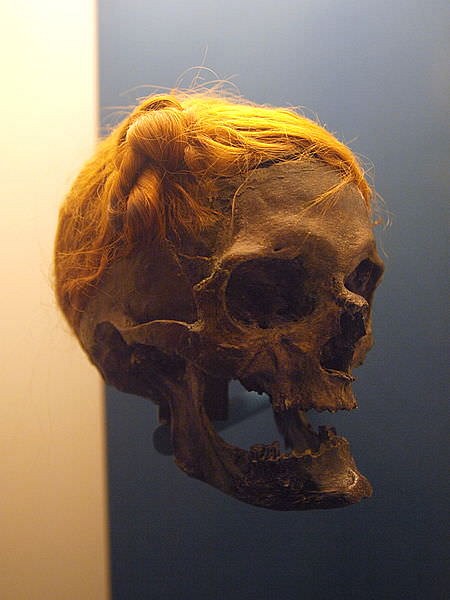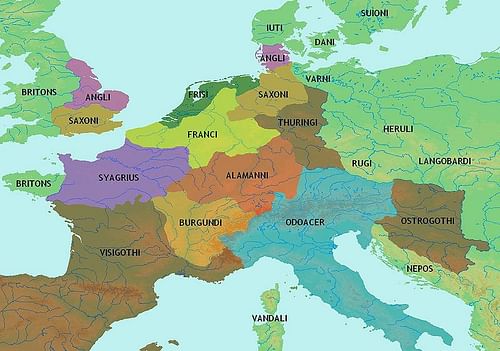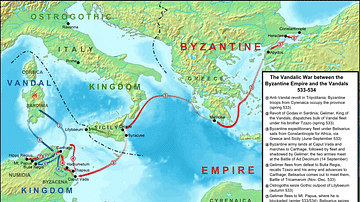
Chrocus (Crocus) was a king of the Alemanni who invaded Roman Gaul c. 256 CE until he was defeated by the Roman legions at Arles and then executed. Conversely, he was a king of the Alemanni who served Rome and supported Constantine the Great (r. 306-337 CE) in his struggle to become sole emperor of the Roman Empire.
According to yet another version of history, he was a Vandal warlord who, after conquering Germania, invaded Gaul c. 406 CE and destroyed every city he encountered until he was stopped by the Romans at Arles and, after being made to view the misery he had wrought, was killed. He lived either c. 256 CE, c. 306 CE, or c. 406 CE, depending upon the source one accepts as valid.
There are three primary sources for King Chrocus and his involvement with Rome: The History of the Franks by Gregory of Tours (written between 580-594 CE), The Chronicle of Fredegar (written in the 7th century CE), and The Epitome of Caesaribus (written late 4th century CE). All three sources present a different view of Chrocus of the Alemanni.
Of these three, Gregory's work is usually accepted as the most reliable concerning Chrocus, but it has been noted that Gregory was not writing objective history; rather, he was using historical events to drive home important theological lessons. The historian and scholar Earnest Brehaut, in the introduction to his 1916 CE translation of Gregory's work, writes:
The History of the Franks must not be looked upon as a secular history. The old title, Ecclesiastical History of the Franks, is a better one descriptively. It is written not from the point of view of the Gallo-Roman or the Frank, but solely from that of the churchman, almost that of the bishop. Gregory does not take a tone of loyalty to the Frankish kings, much less of inferiority. His attitude toward them is cold, unless they are zealous supporters of the church, and he speaks with the utmost disgust of their civil wars which seemed to him absolute madness in view of the greater war between the good and evil supernatural powers. (iii)
In Gregory's view, Chrocus was the embodiment of the forces of evil. His wanton destruction of Gaul and murder of Christians was finally halted by the civilized Romans at Arles, where he was captured and received "just punishment" for his crimes; he was tortured and then executed or, as Gregory writes, "killed with a sword." Prior to his defeat at Arles, however, Chrocus sacked numerous cities, destroyed churches, and slaughtered the inhabitants of Gaul indiscriminately.
According to Fredegar's account, "Not a single city or fortification was saved in Gaul", and Gregory writes that Chrocus' aim was nothing less than "razing to the ground all the buildings constructed in ancient times." Many of these buildings had been temples to pagan gods but were now churches and, in his rampage, he also made martyrs of many bishops and priests of the church.
Gregory of Tours' Version of Chrocus
Gregory (l. c. 538-594 CE) was the Bishop of Tours and a very devout Christian, and his works bear the stamp of his faith. His work focuses on the cunning of King Chrocus and his destruction of the sanctuaries in Gaul, most notably the Vasso Galate, a former temple to Mercury, which was at that time an important church. His passage on Chrocus reads:
Valerian and Galienus received the Roman imperial power in the twenty-seventh place, and set on foot a cruel persecution of the Christians. At that time Cornelius brought fame to Rome by his happy death, and Cyprian to Carthage. In their time also Chrocus the famous king of the Alemanni raised an army and overran the Gauls. This Chrocus is said to have been very arrogant. And when he had committed a great many crimes he gathered the tribe of the Alemanni, as we have stated, by the advice, it is said, of his wicked mother, and overran the whole of the Gauls, and destroyed from their foundations all the temples which had been built in ancient times. And coming to Clermont he set on fire, overthrew, and destroyed that shrine which they call Vasso Galatae in the Gallic tongue. It had been built and made strong with wonderful skill. And its wall was double, for on the inside it was built of small stone and on the outside of squared blocks. The wall had a thickness of thirty feet. It was adorned on the inside with marble and mosaics. The pavement of the temple was also of marble and its roof above was of lead. (I. 32)
Gregory's account thus places the invasion of the Alemanni under Chrocus at some point during the reigns of Valerian and Gallienus (253-258 CE) usually dated to c. 256 CE. After destroying the magnificent temple of the Vasso Galatae, he continued cutting a swath of destruction through the land until he was stopped at Arles where his forces were defeated by the Romans and he was captured and executed. This version of Chrocus' invasion is considered the most reliable because, even though Gregory was using history to make theological points, he seems to have had access to primary documents no longer extant and, within the scope of his work, made good use of them.

Chrocus in Fredegar's Chronicle
The author of The Chronicle of Fredegar is unknown, but it is clear he used Gregory's work as the basis for his passages on Chrocus and omitted those details that he considered unnecessarily moralistic, confining, or personally distasteful. Whether an individual named "Fredegar" actually existed is debated but, based upon references in his work, it is thought the writer (or writers) lived in the region associated with the Alemanni.
He therefore changed Chrocus' nationality from that of Alemanni to Vandal in order to disassociate the conqueror and his destruction of Germania and Gaul from his own people. Following Gregory's main narrative, he also focuses on Chrocus' destructive invasion and the decimation of cities:
There, with cunning, he crossed a bridge over the Rhine at Mainz and first destroyed that city and killed its inhabitants and then besieged all the cities in Germania. When he arrived in Metz, as a divine sign the town wall collapsed at night and the town was taken by the Vandals. However, the people of Trier fled to the city's arena, which they had fortified, and were saved. After that Chrocus invaded all of Gaul with the Vandals, Suevs, and Alans and destroyed a number of cities through siege and others through cunning. Not a single city or fortification was saved in Gaul. When he besieged Arles, Chrocus was captured by a certain soldier named Marius and put in chains. As punishment, he was then led through all the cities that he had destroyed and his impious life was put to an end. Trasamundus succeeded him as ruler. (II, 60, as cited in Goeing, 76-77)
Fredegar makes a number of interesting changes to Gregory's narrative so that, in the words of the historian Schwelder, he "seems to have had a completely different Chrocus in mind than Gregory" (Goeing, 79). In Fredegar's account, Chrocus is a Vandal chieftain and the invasion takes place c. 406 CE. In 406 CE the Vandals were driven into Gaul by the invading Huns and, in 409 CE, they began to settle in Iberia. Fredegar would have been acquainted with the Vandal invasion and so perhaps conflated the Chrocus of the Alemanni with a later Vandal chieftain or, as previously noted, simply did not want Chrocus associated with the Alemanni.
It is also possible that a 3rd-century CE invasion of Gaul by the Alemanni was completely unknown to Fredegar and he thought Gregory must have meant the 406 CE incursion by the Vandals. Schwelder writes:
To Fredegar, the passage in Gregory's work, which attributes Chrocus to the years 253-258, seemed implausible since it did not fit into his chronological scheme of reference - in Fredegar's eyes, the bishop of Tours must have erred and he silently corrected him. (Goeing, 79)
Other accounts of the Vandal invasion also cite a Chrocus as leader, but these come after Fredegar and no doubt relied on him as a source. It is generally accepted that the Chrocus who invaded Gaul was an Alemanni warlord whose people called him their king and was not a member of the Germanic tribe known as the Vandals. It is further accepted that Chrocus' invasion took place c. 256 CE and not c. 406-409 CE.
The Epitome of Caesaribus & Chrocus
The Epitome of Caesaribus was attributed to the Roman historian Aurelius Victor (l. c. 320-390 CE) but is now recognized to have been written by an anonymous author who was most likely pagan (or at least held a dim view of Christianity and Christians) in the late 4th century CE. This author places King Chrocus as the leader of an Alemanni unit known as the Regii ("of the king") in the Roman army who, in 306 CE, supports Constantine's ascension as emperor.
Schwelder has noted that, since the author of the Epitome was hostile to Christianity, he could have purposefully used the figure of Chrocus from the past - an Alemanni king associated with destruction and cruelty - to malign the Christian emperor and that "the passage could therefore be a later fabrication" (Goeing, 81). It is possible that this later Chrocus was a different leader of the Alemanni than the Chrocus who invaded Gaul, but this is unlikely. There is no other source that makes mention of a Chrocus of the Alemanni associated with Constantine the Great and, with a figure of such looming significance as Constantine, one would expect more information on a man who assisted in his rise to power.
The Epitome of Caesaribus consists of short biographies of Roman rulers from Augustus to Theodosius I which highlight important moments of their reigns, so it is possible that the anonymous writer or writers simply did not have time or space to elaborate on the role Chrocus is said to have played in Constantine's ascension.
Even so, the fact that no other source mentions a Chrocus in such an association has led scholars, Schwelder among them, to conclude that the Chrocus character in the Constantine biography is a fiction and was most likely added to discredit Constantine's reputation by suggesting he was supported by someone as disreputable as Chrocus.
As the literate audience would have been largely Christian by the end of the 4th century CE, however, the intended effect was probably never realized. Even those Christians who would have recognized the name of Chrocus from 200 years before would hardly have been upset that the first Christian emperor was aided by a murderous barbarian; this would have simply been interpreted as part of God's grand design to bring good from whatever source he saw fit. Later sources rely on the Epitome of Caesaribus for their version of Chrocus' role in Constantine's ascension and, in the modern day, Chrocus continues to be cited as an Alemanni king and commander in the Roman army who supported Constantine, even though it is likely no such commander existed.
Conclusion
The real Chrocus, King of the Alemanni, may never be known. In the modern day, he is of interest not so much because of what he did but because he presents such an excellent example of how history is recorded and what makes a historical event "true" or "not true". Schwelder writes:
Taking all three versions of Chrocus into account, one can see that Chrocus was a suitable, mouldable figure who could be fitted into a line of argument to strengthen different views. The historical Chrocus was intended to be forgotten; the literary Chrocus was adapted and included to heighten the effect in different master narratives. (Goeing, 81)
The best one seems to be able to say is that once there was an Alemanni king named Chrocus who invaded Gaul and lay waste to the cities and churches he found there before he met defeat and was executed by the Romans. His motivation for the invasion is unknown, and even the period in which he lived and reigned is debated. As the sub-title of the Anja-Sylvia Goeing text phrases it, history consists of what is kept and what is discarded and, in the case of King Chrocus - as, no doubt, with many others - those events that did not fit the historian's world view and narrative were discarded; the result is history.






